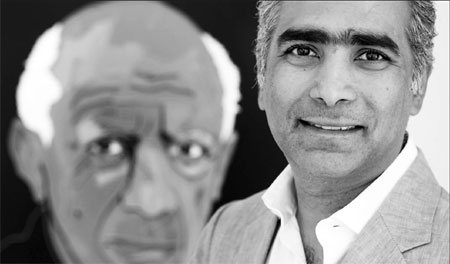 |
|
Sundaram Tagore seeks out artists with a world perspective at his gallery in Hong Kong. [Edmond Tang]
|
If there's one street in Hong Kong that best captures the city's East-meets-West vibe, it is Hollywood Road in Soho district. With contemporary art galleries and posh foreign restaurants jostling for attention with antique furniture shops and vintage clothing stores, the road exudes an emotion and exoticism that is quintessentially Hong Kong.
It also offers an apt metaphor for the kind of cultural dialogue that Sundaram Tagore, the great grandson of the master poet and Nobel Prize laureate Rabindranath Tagore (1861-1941), has championed over the years. Contributing his share of the effort to stir up the local cultural hodgepodge, the man opened his eponymous gallery - the Sundaram Tagore Gallery - on Hollywood Road in April this year.
"I was promised a site twice the size of this gallery by the Governor of Dubai," he says. "But I wasn't tempted because I wanted to be here. It's always a great experience to go to a culture where people want you to be there."
Indeed, with all the latest talk about galvanizing the city's creative industries, Hong Kong has craved a high-profile addition to its growing list of international galleries.
That said, who would not have opened their arms to a Tagore given the chance? Almost 70 years after Rabindranath Tagore's death, the family name still echoes around the world.
For Sundaram Tagore, a man who spends 70 percent of his time traveling, the art he displays in the 200-sqm gallery is a toast to that nomadic spirit. Each artist is a migrating soul in an ever-changing cultural landscape, which they explore with the same intrepidity Tagore displays to explore the globe.
"I try to seek out artists with a world perspective, who absorb different cultures without homogenizing their own identity," he says.
One of them is the Californian artist Lee Waisler, who uses wooden strips to outline and highlight the features of his subjects, giving a haunting quality to his portraits of Mahatma Gandhi, Sigmund Freud and the American Chinese actress Anna May Wong.
Tagore, a student of art history, says "synthesis" is the key word. "Modernism rejects tradition. But for ancient nations like China and India, tradition is too deeply entrenched to be rejected. That's why post-modernism was born - to allow synthesis to take place and to give birth to hybridism," he says. It is a process he calls "over-arching", with the two forces of tradition and modernity rising above each other instead of clashing.
He has his way to make a complicated theory appear less so.
"You are from China, I'm from India, we eat in a French restaurant, listening to probably Mexican music - this is synthesis," he says.
Predictably, one group of artists that Tagore is interested in showing is Chinese artists living overseas. "They have been affected by experiences outside their own culture and as a result each has a unique perspective to share," he says.
The gallerist had a major studio tour to Beijing last February, during which he met local artists and visited their breeding grounds including the famous 798 Art District.
"The sort of cultural confluence that gives rise to big ideas must happen to an artist as a natural process, a rather unconscious one," he says. It leads nicely to a swipe at today's ubiquitous jumbling of cultural symbols in artworks as "cheap pastiches".
"In a sense, Hong Kong artists are more genuine, mainly because no one cares about them - all the attention right now is on their mainland counterparts," says Tagore, referring to the meteoric rise of prices for art "made in China".
Despite his reluctance to exploit his name, Tagore admits that it was his family that instilled in him a "world vision". "All my family members are die-hard internationalists," he admits.
In 1902, Rabindranath Tagore founded a university in West Bengal, based on the ancient model of mentor-student. Later, the university was renamed Visva Bharati, meaning "world university". It had a mission to attract people from far and wide.
As a child, Tagore often ventured into the university school, where teachers and their disciples sat barefoot under the giant trees. As in his great grandfather's poems, this was a world perfumed by the scent of knowledge and filled with all kinds of enchanting promises.
There was also an initiation into the jungle of the wild, conducted by Tagore's painter parents.
"Sometimes, they'd take me out of school and away from friends for one month. We set up camps in tribal villages in remote parts of India, where they painted and did research," he says.
Tagore remembers being taken to Orissa, on the east coast of India. He was bouncing a ball outside the camp, when it rolled out. He chased it and there, just meters away, a few tiger cubs were lying on the grass.
"I called out to my nanny who came, saw the cubs and immediately grabbed me and ran into the car," he says. "But experiences like this really opened my eyes to the diversity of our world."